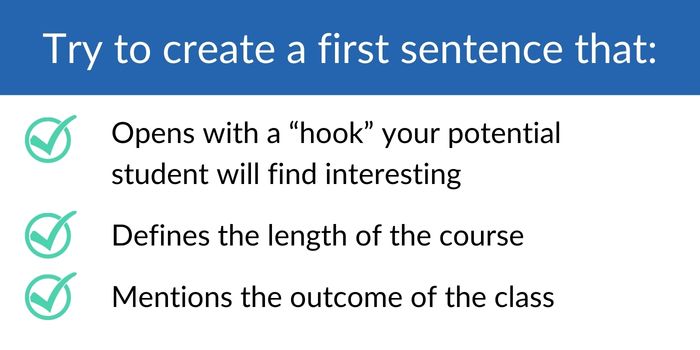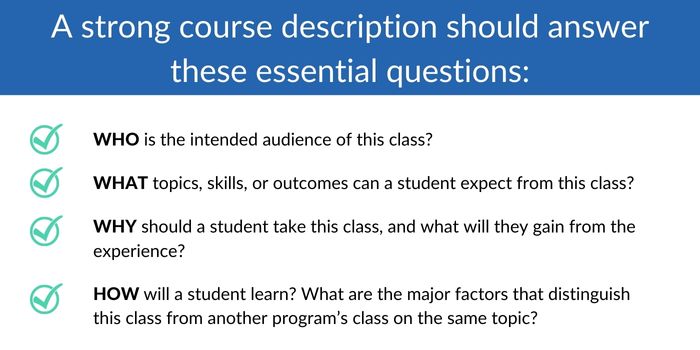How To's
How to Write a Course Description: Examples & Templates

For something that’s usually only a bit longer than the average tweet, a course description is a surprisingly powerful marketing tool. In fact, your course descriptions are one of the last marketing messages students see before they click “enroll.” Short but important, these can be tricky to write. That’s why we’ve put together some course description examples that will hook students and make your job easier. (If you’re wondering whether you should use AI to write your course descriptions, we wrote a whole separate article on that.)
Use these course description examples and our template below to write your own course descriptions that entice students to click “Register now!”
Along with sharing our list of best practices, we’ll dissect a series of examples so you can see exactly what works and why. Use these course description templates to make creating your course catalog a breeze!
Course Description Example 1: Get Students “Hooked”
Open every course description with a sentence that “hooks” the reader and then conveys the essential information in an accessible and engaging way. A hook can be anything that captures the prospective student’s attention or encourages them to keep reading.
These can take a variety of forms, including:
- A surprising statistic or number.
Example: 70% of adults report that their sleep is insufficient at least one night every month, but you won’t be one of them after learning about sleep hygiene, sleep debt, circadian rhythms, and the link between sleep and overall health in this 2-hour session. - A relevant quote from a famous person.
Example: Meryl Streep says the essence of acting is to be “curious about other people,” and in this 6-week class you’ll get curious about characters from six canonical dramatic works as you learn how to break down a character, study a character, create a character, and become that character. - A play on a familiar saying or expression.
Example: The early bird gets the worm, but you won’t need worms at all after this 3-session course on how to make your own plastic fishing lures to bring on your next trip to the water. - A callout to a specific audience.
Example: For a class on poker strategy, your “hook” could read, “Calling all card sharks for this 4-week class that will transform your poker game as you learn how to read your opponents, spot tells, understand game theory, check-raise, bluff, and more.”
Hooking the attention of your ideal student is important, but it’s just part of what a strong first line can do. You can pack a lot of information into this one sentence!

Course Description Example 2: Keywords, Keywords, Keywords
Keywords help search engines find your course descriptions, which helps students find them too. When you write a course description, try to use the words a student is likely to use to search for courses on that topic. Use a tool like Semrush or Moz to do some keyword research. Find keywords that you can target and build your course description around those terms.
But don’t go overboard. Remember that course descriptions are supposed to help the student, not just fit an algorithm. Use the keywords that make sense in context and relate closely to your program.
Here’s an example of a course description that uses keywords effectively:
Course Title: Breaking and Baking Bread
Course Description: Not your average bread baking class, this 6-week course shares the joy of making bread from scratch by breaking down the essentials of a great starter and giving expert tips about yeast and flour. You will bake breads such as sourdough, rye, brioche, challah, ciabatta, and popovers while learning about oven heating, mixing, kneading, fermenting, egg washing, and more. Your guests will clamor for the bread basket at your kitchen table and luxuriate in the smell of warm bread in your home after you become part of the ancient tradition of bread baking.
This course description uses variations on the keyword “bread baking” to optimize for SEO. Try to use your selected keyword in the course title. Include three to five relevant keywords in the description as long as it sounds natural to do so.
Course Description Example 3: Outcomes Over Operations
While instructors tend to focus on things like course mechanics, lessons, and assignments, prospective students are more interested in what they’ll gain from taking the course. Will they earn a certification? Will they be a member of a group? Will they have a new skill to put on their resume?
Use the course description to tell students about the outcome, such as:
- A formal certification
- An advanced understanding of the topic
- Access to an exclusive group
- A tangible skill or experience
- A portfolio
The outcome should be closely related to the class topic and something that the student is likely to value. For example, a course on finance might promise students a personalized plan for reducing debt while a course on fashion might help students define their own style. Outlining these outcomes helps the student recognize the value the course will bring to their life. It can also set your courses apart from others on the same topic.
The SWBAT strategy can help define the outcome students can expect from a course. This stands for “Students Will Be Able To …” by the end of the class.
Define your program’s brand promise — the commitment you make to your students about the quality, value, and benefits of your classes — by pinpointing the outcome students can expect from each class. A simple way to do that in your course descriptions is by using the SWBAT strategy: this stands for “Students Will Be Able To …” by the end of the class. Whether it’s paint with watercolors, speak basic Spanish, or play a song on the piano, highlight the specific outcome for students.
Here’s an example of a course description that focuses on the outcome:
Course Title: Finding Your Voice Through Songwriting
Course Description: Make music that expresses your true self in this 12-session class that studies wordplay, poetry, and phonics to help you write lyrics that resonate. You’ll write and workshop two full songs and perform one at the final class meeting so you can experience the full process of songwriting, from ideating and conceptualizing to drafting, editing, revising, and finalizing. You’ll break down classic songs, mix melodies, and learn how legendary songwriters mastered their craft to gain a new appreciation for the art of making music.
This description outlines several outcomes:
- Writing two full songs
- Performing
- Experiencing the full process of songwriting
Each of these might be useful to the student on their own, but together they make for a unique and valuable course.
Course Description Template
We’ve covered a lot of examples, but let’s cut right to the heart of the matter.

A template that works for nearly every course description looks like this:
Course Title: Topic + Intended Audience (or) Topic + Outcome
Examples:
- Topic + Intended Audience: Mindful Parenting for Busy Parents
- Topic + Outcome: Storytelling Through Portrait Photography
Course Description:
Sentence 1 hooks the reader by including the important information in an accessible, interesting way.
Sentences 2-4 tell students what they gain from taking the course and include keywords.
Sentence 5 tells students how to register.
You can add a few more sentences if you need extra space to truly explain your outcomes and course structure. Just don’t get too lost in the details. If you do need to provide a lot of supplementary information like materials lists or policies, consider adding those as an attachment students can download and review.
Here’s an example of how a course description comes together.
Course Title: Make Your Home Garden Grow
Course Description: (1) Whether you have a green thumb or a brown one, this 8-session class will teach you how to grow and maintain an indoor garden of peperomia, snake plant, philodendron, English ivy, hoya, pothos, and calathea. (2-4) No matter the size of your space, you’ll create a thriving forest of greenery and gain access to a virtual gardening library which includes a comprehensive care spreadsheet for 200+ common houseplants, a guide to watering, an encyclopedia of perennials, and a manual for pruning. With a live online class format, you’ll get to work in your own garden space while learning about soil composition, sun exposure, seed germination, pest control, tool care, and more. (5) Register now!
A course description like this moves students to want to register. So make it simple for them to do. CourseStorm makes course registration simple and seamless. Add registration links directly to your course descriptions so students can go from interested to registered quickly and easily. Contact us today to get started or start your free trial now.

Nic Lyons
Nic is skilled in scaling start-up edtech and education organizations to growth-stage success through innovative marketing. A former journalist and copywriter, Nic holds a postgraduate certificate in digital and print publishing from Columbia University School of Journalism's publishing course.
